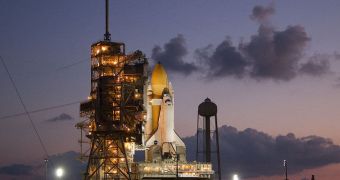Engineering teams at the Kennedy Space Center (KSC) announce that they finished repair work on the space shuttle Discovery, and with time to space. Experts still have 10 days to conduct final checks, and determine whether to allow the orbiter to fly or not.
The STS-133 mission to the International Space Station (ISS) was originally scheduled to blast-off on November 1, but a series of glitches found before the launch attempt delayed the plan.
The following days, rainy weather and other glitches forced consecutive delays, until finally a lot of damage was found on the shuttle's external fuel tank. NASA officials then decided to postpone the mission until at least December 1.
The decision was taken so that repair crews have sufficient time to conduct the necessary repairs. The launch window Discovery could have used closed at the end of the first week in November, and will open again at the start of next month.
Yesterday, November 22, officials with the American space agency announced that all major damages which have been identified on the orbiter and its external tank and boosters have been patched up.
The current launch manifest calls for Discovery to take off no earlier than December 3 at 2:52 am EST (0753 GMT). The spacecraft sits atop its tanks and boosters on Launch Pad 39A, the only facility in the US that can still launch shuttles.
NASA spokesman Allard Beutel explains that “the stringer cracks (on the fuel tank) were repaired last week and foam was reapplied during the weekend. [Now,] they're pretty much done with the overall repair work.”
Tomorrow, November 24, a team of NASA experts, engineers, and mission planners, controllers and managers will analyze the repairs, and will determine whether the shuttle can fly to the ISS as planned.
If Discovery passes this review, than a final assessment will be conducted on November 29. If that is completed with flying colors too, than the shuttle is on its way to finally launching into space.
After the orbiter returns, Endeavor's flight is theoretically the last shuttle mission on the NASA flight manifest, Space reports.
But Congress recently passed legislation that may allow for another orbiter flight in June 2011. If the plan is approved, than Atlantis will most likely conduct the STS-135 mission.
As the space shuttles retire, the United States will find itself in a position where it will not be able to access space directly, neither with crews nor cargo. It will therefore have to rely on international partners in order to get to the ISS.
Russia and China will remain the only two countries with the ability to put people in low-Earth orbit (LEO). The European Space Agency and JAXA will also be able to deliver cargo to the space station.
The US will have to wait for a few more years, until private corporations manage to develop their planned systems sufficiently to allow for routine deliveries to LEO. There are several companies in this race, but they are all at least a couple of years away from achieving their goals.
In the mean time, NASA will cooperate with ESA, JAXA and RosCosmos in securing seats for its astronauts, as well as room for the supplies it wants to send to astronauts in orbit. Crews will arrive on the ISS aboard Russian Soyuz space capsules.

 14 DAY TRIAL //
14 DAY TRIAL //